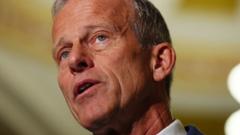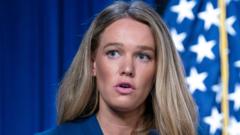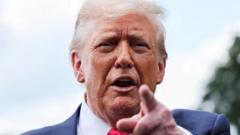American luxury buyers may see higher prices on their favorite brands as tariffs are implemented.
# Luxury Goods Sector Faces Uncertainty Amid New Tariffs

# Luxury Goods Sector Faces Uncertainty Amid New Tariffs
Amid new tariffs, luxury brands brace for a slowdowns unlike any seen before.
As American consumers prepare to adjust their spending habits due to new tariffs imposed by the Trump administration, the luxury goods sector is grappling with an unexpected challenge. Tariffs amounting to 20 percent on imports from the European Union have raised red flags among luxury brands, leading to speculation about potential price hikes for coveted items such as designer handbags and high-end watches.
Originally, the luxury market had been poised for a resurgence, anticipating a wave of consumer spending buoyed by tax cuts and a strong economy. However, with U.S. shoppers accounting for 24 percent of the global luxury spending, the abrupt introduction of these tariffs sends ripples through an already fragile market. According to Bain & Company, last year's total expenditures on luxury goods reached an impressive $1.62 trillion worldwide.
Euan Rellie, co-founder of BDA, an investment bank with a focus on the fashion sector, voiced concerns over the U.S. market's future. "The U.S. was supposed to be the savior of the luxury goods industry, but the current administration’s actions suggest otherwise," he noted. With the U.S. economy facing challenges, including a downturn in luxury sales in China and a recession in Germany, the landscape for luxury brands has grown increasingly precarious.
While high-profile brands such as LVMH, Burberry, and Chanel have remained tight-lipped regarding their strategies moving forward, there is a palpable fear of how these tariffs will impact pricing. LVMH, which includes illustrious names such as Louis Vuitton and Dior, relies significantly on U.S. revenue—the U.S. accounted for one-quarter of the luxury group’s 2024 earnings.
With the stakes higher than ever, luxury consumers may soon find themselves paying premiums for their favorite European products, potentially altering purchasing habits in a market that thrives on exclusivity and prestige. As luxury brands await clarity, every decision becomes critical, leaving many in the industry waiting with bated breath.
Originally, the luxury market had been poised for a resurgence, anticipating a wave of consumer spending buoyed by tax cuts and a strong economy. However, with U.S. shoppers accounting for 24 percent of the global luxury spending, the abrupt introduction of these tariffs sends ripples through an already fragile market. According to Bain & Company, last year's total expenditures on luxury goods reached an impressive $1.62 trillion worldwide.
Euan Rellie, co-founder of BDA, an investment bank with a focus on the fashion sector, voiced concerns over the U.S. market's future. "The U.S. was supposed to be the savior of the luxury goods industry, but the current administration’s actions suggest otherwise," he noted. With the U.S. economy facing challenges, including a downturn in luxury sales in China and a recession in Germany, the landscape for luxury brands has grown increasingly precarious.
While high-profile brands such as LVMH, Burberry, and Chanel have remained tight-lipped regarding their strategies moving forward, there is a palpable fear of how these tariffs will impact pricing. LVMH, which includes illustrious names such as Louis Vuitton and Dior, relies significantly on U.S. revenue—the U.S. accounted for one-quarter of the luxury group’s 2024 earnings.
With the stakes higher than ever, luxury consumers may soon find themselves paying premiums for their favorite European products, potentially altering purchasing habits in a market that thrives on exclusivity and prestige. As luxury brands await clarity, every decision becomes critical, leaving many in the industry waiting with bated breath.






















